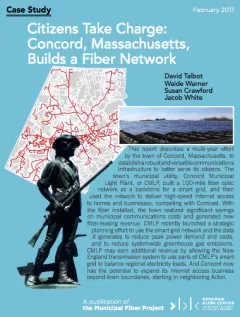
Citizens Take Charge: Concord, Massachusetts, Builds a Fiber Network
A case study by David Talbot, Waide Warner, Susan Crawford, and Jacob White
In this case study, the authors chronicle the creation of the municipal smart grid and fiber-to-the-home Internet access project in the town of Concord, Massachusetts, and quantify early paybacks on the town’s investments. (A companion report, Smart Grid Paybacks: The Chattanooga Example, describes paybacks on a national model for such a project, in Chattanooga, Tennessee.) In 2009, Concord voters authorized the town’s municipally-owned electric utility (Concord Municipal Light Plant, or CMLP) to build a $3.9 million smart grid which included a 100-mile fiber-optic network passing 95 percent of premises in town. Next, in 2013, the town borrowed $600,000 to fund the startup of an Internet access business, called Concord Light Broadband. The town began making fiber connections to subscribers’ premises in early 2015.
By the end of 2016 CMLP was serving about 750 customers with service of up to 200 Mbps upload and download. Today the town’s network has added reliability to elements of the town’s electricity grid, helped the town avoid $108,000 in annual communications costs, and generated $88,000 in annual leasing revenue. The town has recently begun a strategic planning process in part to help identify how the smart grid can best be used to reduce expensive peak-hour electricity demand, reduce operating costs, enhance revenue, and cut greenhouse gas emissions. One vendor estimates that CMLP could earn $125,000 in revenue by allowing the regional transmission system to use the town’s smart grid to help balance regional electricity supply and demand. Although the financial paybacks on the town’s project are not yet fully covering debt service and operating costs, the long-term prospects are bright, especially given that the fiber will last 30 or more years, and debts on the smart grid will be paid off after 15 years.
A publication of the Municipal Fiber Initiative
You might also like
- communityThe Digital Panopticon Nightmare